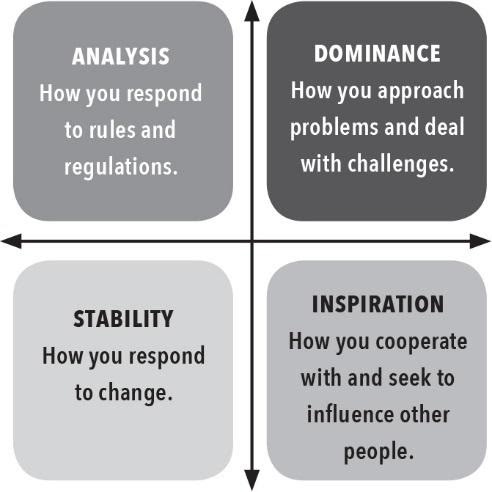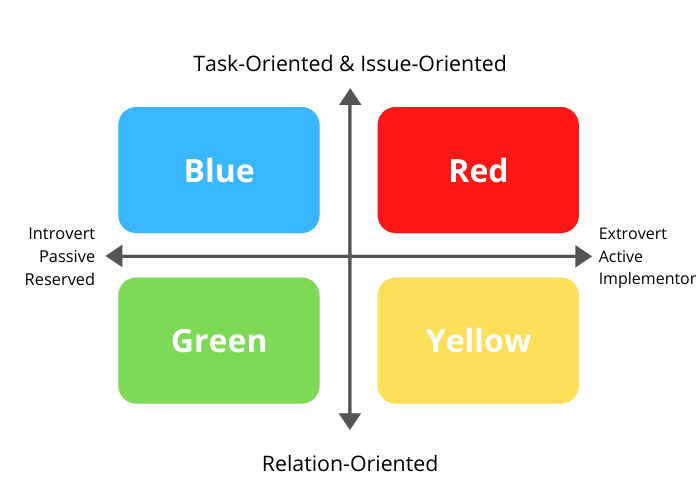
Do you find it difficult to get along with certain people? Wonder why some folks are so hotheaded or easily distracted, while others prefer to do nothing?
Enter the wild — and wacky — world of human behaviours!
Anybody in a position of leadership or management would have learned myriad ways of classifying people.
From Enneagrams to MBTI (Myers Briggs Type Indicator) to Personality Types (Type A, Type B etc), numerous methods have emerged over the years to categorize (and manage) people based on their unique characters, attributes and personalities.
Thanks to the bestselling book Surrounded by Idiots by Thomas Erikson, I now learn that we can classify human behaviour based on colours: Red, Blue, Green and Yellow.
Inspired by the DISA (or DISC) system, the techniques used to manage these four types of human behaviours are useful for anybody in a position of management and leadership.
But first, let us look at a brief history of how these behavioral archetypes came about.
Greek and Roman “Humour”
It all started with Hippocrates, who believed that your health is good when the four humours (liquids, not laughter!) — blood, yellow bile, black bile and phlegm— are in balance. The system, further refined by the Roman physician Galen, is called the humoral system, and comprises four fundamental personality types:
- Sanguine: These are the happy-go-lucky optimistic folks whose temperament are controlled by too much “blood” (Latin: sanguis) in his body.
- Choleric: These are the fiery, temperamental and driven people controlled by their “yellow bile” or liver (Greek: chloe).
- Melancholic: These folks are gloomy pessimists (moody folks) who are controlled by too much “black bile” found in the spleen (melaina chloe means “black bile” in Greek).
- Phlegmatic: These are the folks, just like mucous (snigger), who are viscous (ie slow and sluggish). They are controlled by the mucus (Greek: phlegma).
The DISA (or DISC) Profile System
Inspired somewhat by the Greeks and Romans, psychologist Walter Moulton Marston created the DISC model way back in 1928. This comprises four different divisions in personality types:
- Dominance: produces activity in an antagonistic environment
- Inspiration: produces activity in a favourable environment
- Submission: produces passivity in a favourable environment
- Compliance: produces passivity in an antagonistic environment
This was later modified to become DISA (Dominance, Inspiration, Stability, Analytical ability) which relates to how people approach problems and deals with challenges (Dominance), likes to influence people (Inspiration), is receptive to change (Stability), and follow rules and regulations (Analysis).
You can read the chart below to see how it looks like.

Many of us have taken the DISC or DISA test. You can try taking a free one here.
The Four Colours: Red, Yellow, Green and Blue

Further Adapted from the DISA system, the four-colour behavioral framework by Thomas Erikson categorizes the main behaviours according to four colours: Red, Yellow, Green and Blue.
These can be understood as belonging to the four dimensions as follows:

Courtesy of hustle escape
The four colours map to the Dominant Inspiring Stable and Analytical (DISA) system as follows:
ANALYTICAL (BLUE)
|
DOMINANT (RED)
|
STABLE (GREEN)
|
INSPIRING (YELLOW)
|
Most people have a combination of two colours (80 percent), with 5 percent having only one colour, and the rest with three colours.
Here are some of the unique personality and behavioural traits for each of the colours.
Red Behaviours (Dominant)
Also known as the cholerics, red folks are dynamic, driven, dominant and often fairly impatient.
Other than wanting things their way, they also work hard and push hard — both themselves as well as those who work with them.
Natural leaders, reds are task-oriented extroverts who enjoy challenges. They decide quickly, and are comfortable taking risks.
In terms of positive traits, they are strong-willed, independent, persistent, gritty, and determined to see something to the end.
However, reds may also end up brushing (and pissing) people off, and could appear to be too pushy, tough, strict and inflexible.
Yellow Behaviours (Inspiring)
Termed as the sanguine folks with their heads in the clouds, yellows are optimistic, bright, cheerful and highly sociable.
They are the livewire of the office party, enjoy talking, and is extremely extroverted.
A yellow will also be fairly easy going, charming, optimistic, and open.
In terms of positive traits, yellows have a good dose of enthusiasm, are stimulating company, outgoing, and creative.
However, yellows are also known to be disorganised, manipulative, egotistic, bad listeners, and hot-tempered.
Green Behaviours (Stable)
Also known as the phlegmatics, greens are the most stable and the average of all the colours.
They are calm, leisurely, easygoing, and social. Greens are also relational in nature, and fairly predictable.
In terms of positive traits, greens are likely to be supportive, respectful, obliging, reliable, pleasant, team players and good listeners.
However, greens may also be stubborn and passive, compliant, change-resistant, dependent, indecisive, and risk-adverse.
Blue Behaviours (Analytical)
Finally, we come to the blues, a.k.a the melancholics.
As their name suggests, blues can be pessimistic and realistic. They are also analytical in nature — classifying, evaluating, assessing and weighing each option carefully before taking action.
Being perfectionists, blues may take a little longer — or a lot longer — to make a decision. They are also more cautious than all other colours.
In terms of positive traits, blues are diligent, thoughtful, meticulous, methodical, and demanding.
However, blues are also critical, narrow-minded, conservative (following the rule book), moralizing and fastidious.
How to Manage People with the Four Colours

Given when we know about people with the different colour traits, here are some ways to manage these folks in real life.
Managing Red Behaviours
To adapt to a red’s speed, you got to move faster. Speed up! Speak quickly! Cut out the fluff. Skip the small talk.
Focus on the core point of your message. Slice your PowerPoints by half. Or less.
To gain their confidence, show that you work equally hard.
As reds aren’t very meticulous and detail-oriented, help them keep an eye on the details. Explain that the results will be better if they focus on small but crucial elements of the project.
To help reds to slow down and reflect more, give examples of why being too hasty may be risky. Force the red to wait for others, and explain the benefits of getting other members of the team on board.
Focus on the facts, and be firm about sticking to your guns about the virtue of slowing down.
Do also stand up to boorish red behaviours. Be firm that you won’t tolerate nasty remarks or tantrums. Don’t be bullied.
Managing Yellow Behaviours
As the happy easily distractible bunnies in your circle, you need to keep up the warm and friendly vibes in the company of yellows. Smile a lot. Laugh. Have fun.
Like the reds, yellows aren’t good with details. Hence, you should skip the boring minutia. Focus on the big questions.
Show that you also follow your gut just like your yellow friend or colleague. Beyond that, zoom in on novelty, with expressions like “state-of-the-art”, “first time ever”, “newly developed”.
Use an open body language and engage in storytelling. Show interest in him or her as a person too — not just a customer, colleague or boss!
To catch the attention of a yellow, you need to repeat yourself and follow up (in writing) with the person. Lots of reminders are needed!
You’ll also need to ensure that the yellow commits himself to timelines and deadlines. Help them get organised by creating structure for him.
Also, you’ll need to discreetly let them know that there are others who are also in the team. Nudge them gently (but firmly), and ensure clarity in communication.
Managing Green Behaviours
As the more fear-ridden group, greens will need security. Show them that you are prepared to listen to her anxieties.
Allow greens their moments of peace, quiet and inactivity when they feel stressed. They need time to calm down and feel safe and secure.
To reassure greens, explain every step that you are going to take. Give them the roadmap. Tell them exactly what is going to happen next.
Being social people, greens care about how they look to others. Do not deliver criticism in public. Instead, do it in private.
Should change be inevitable, find a way to break down the process into small bite-sized pieces. Take time to go through it. Again. And again. And again.
You’ll also have to take the helm when managing a large group of greens.
Managing Blue Behaviors
Being the meticulous and comprehensive folks that they are, you’ll need to think through all the scenarios when you work with blues.
Prepare in advance, and ensure that you know as much as you can. And if you don’t know the answer, just be open to say so.
Like the reds, blues don’t like small talk. Hence, stick to the task at hand, using checklists if necessary.
In terms of language, stay away from visionary and dreamy language. Keep your feet planted on the ground. Stick to your excel spreadsheets!
Do also keep to the facts, and ensure that you work on quality and high standards in any tasks.
To convince a blue that she needs to work with other people, explain how her criticisms may affect other people’s feelings.
Also, while being methodical is good, it may also slow things down too much. Highlight why being timely is important at times. Talk about how fast things are moving in the world.
Finally, let a blue friend know that sometimes decisions must be made without all the facts at hand. Using intuition isn’t necessarily bad.
Courtesy of MudaMasters
Conclusion
What I’ve covered above are the key points of the book Surrounded by Idiots. There are lots of other gems in the volume, and I encourage you to get a copy for yourself.
In the book, you’ll also learn how to deliver bad news to the different colour types, which colours get along (and which don’t), how you can help people with different colours to manage stress, as well as how you should communicate in writing.
Have you heard of the DISC, DISA or four colours in behavioural analysis? Which colours do you think you belong to?
For me, I’d probably fall into a mix of red and yellow, with some hints of blue. What about you?


